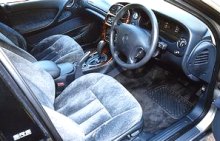 The
Statesman is surprisingly close to Buick Park Avenue in philosophy.
Like
the American car, it is near-luxury but not really luxury. It is big
and
bulky, softly sprung to please old men. It is reliable but feels cheap.
And both cars are a stretched version of an existing platform - for
Buick
it is GM's G-platform, for the Australian car it is the Commodore
platform. The
Statesman is surprisingly close to Buick Park Avenue in philosophy.
Like
the American car, it is near-luxury but not really luxury. It is big
and
bulky, softly sprung to please old men. It is reliable but feels cheap.
And both cars are a stretched version of an existing platform - for
Buick
it is GM's G-platform, for the Australian car it is the Commodore
platform.
The Statesman is built out of Commodore's parts bin. The chassis is lengthened to 5.2 meters - the same as the longest Cadillac today, with an astonishing 2.94 meters wheelbase to match. In many ways it is as big as a LWB Mercedes S-class, but like Buick, size does not reflect its status as an low-priced executive car. Maximum space per dollar still means a lot to Australian (and American too). Underneath the huge body is purely Commodore, with the same not-so-advanced suspension, the same old-tech engines (204hp 3.8 V6, 230hp 3.8 supercharged V6 and 300hp 5.7 V8, all are push-rod engines) and the same 4-speed automatic. Although it does not have any mechanical advantage over the bread-and-butter Commodore, its 1.7 ton kerb weight should not harm performance too much.
The cabin is one of the biggest in the world today. No one knows why Holden needs so much extra room in front of your knees. Instead, I would have liked to shortened the chassis for more rigidity and better handling. Space aside, there are a lot of equipment, but you won't find advanced technology like keyless entry or big computer screen. Alright, buyers in their 50s or 60s may not be fancy with high-tech, but I think they should love faultless fit and finish, soft-touch plastic, beautiful wood and leather as well as high-quality switch gears ? Statesman has none of them. Sadly, its interior feels very cheap - not by exec standard but by family car standard as well. The dashboard design is dull to look too. For a car so
outdated in
philosophy and so poor in execution, the conclusion is again this one:
unless you need those interior space or you love a lot of metal for the
money, look elsewhere. If it is not sheltered by Australia's
protectionism
- hence cheaper than a BMW 320i there, it would not have been surviving.
|
| The above report was last updated on 2 Dec 2001. All Rights Reserved. |
 Performance
is never a priority of this car, not only first priority but also
second
and third priority. Acceleration is not slow unless you choose the
normally
aspirated V6, but without a decent chassis the driver is unlikely love
or dare to drive quickly. Predictably, the Americanised Australian car
handles poorly. Thanks to the soft suspensions and huge body, it hates
attack corners at anything other than leisure speed. It rolls, pitch,
dive
severely, floats up and down on ripples. That might not be a problem
for
its target buyers, but what about refinement ? sorry, the rough edges
of
Commodore's hardware becomes more obvious in this near-luxury model.
The
pushrod engines are harsh at high rev, especially the base V6; NVH
suppression
in the cabin is far from executive car level; the automatic is clunky
at
shifts and it is 4-speed only; the weighting of speed-sensitive power
steering
is inconsistent and non-linear.
Performance
is never a priority of this car, not only first priority but also
second
and third priority. Acceleration is not slow unless you choose the
normally
aspirated V6, but without a decent chassis the driver is unlikely love
or dare to drive quickly. Predictably, the Americanised Australian car
handles poorly. Thanks to the soft suspensions and huge body, it hates
attack corners at anything other than leisure speed. It rolls, pitch,
dive
severely, floats up and down on ripples. That might not be a problem
for
its target buyers, but what about refinement ? sorry, the rough edges
of
Commodore's hardware becomes more obvious in this near-luxury model.
The
pushrod engines are harsh at high rev, especially the base V6; NVH
suppression
in the cabin is far from executive car level; the automatic is clunky
at
shifts and it is 4-speed only; the weighting of speed-sensitive power
steering
is inconsistent and non-linear.